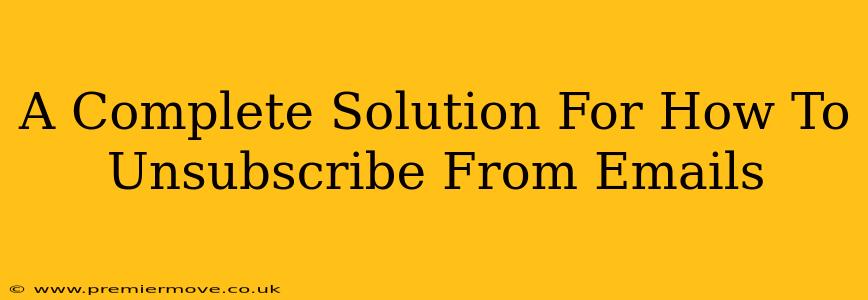Are you drowning in a sea of unwanted emails? Feeling overwhelmed by overflowing inboxes and constant notifications? You're not alone! Millions struggle with email overload daily. This comprehensive guide will show you exactly how to unsubscribe from emails effectively, reclaiming your inbox and your sanity.
Why Unsubscribing Matters
Before diving into the how, let's talk about the why. Unsubscribing from unwanted emails isn't just about tidying up your inbox; it's about:
- Improved Productivity: A cluttered inbox leads to a cluttered mind. Unsubscribing frees up mental space and allows you to focus on important tasks.
- Enhanced Security: Many unsolicited emails contain phishing scams or malware. Reducing your exposure to these emails significantly minimizes your risk.
- Reduced Spam: While unsubscribing doesn't completely eliminate spam, it helps train email providers to filter out similar unwanted messages more effectively.
- Privacy Protection: By unsubscribing, you're taking control of your data and limiting the amount of information companies collect about your online activity.
How to Unsubscribe from Emails: A Step-by-Step Guide
The process of unsubscribing varies slightly depending on the email you're receiving, but the general steps remain consistent:
1. Locate the Unsubscribe Link
Most legitimate emails include an unsubscribe link. Look for it at the bottom of the email. It's usually in small print and may be labeled as "Unsubscribe," "Manage Preferences," "Manage Subscriptions," or something similar. Sometimes it might be hidden within a privacy policy or terms of service link. Be thorough in your search!
2. Click the Unsubscribe Link
Once you find the link, click it. This will usually take you to a webpage where you can confirm your unsubscription.
3. Confirm Your Unsubscription
Some services require you to confirm your request to prevent accidental unsubscribes. You might need to click a button, enter a verification code, or confirm your email address. Follow the instructions provided on the page.
4. Add the Sender to Your Spam Filter (If Necessary)
If you continue to receive emails after unsubscribing, or if you're dealing with blatant spam, don't hesitate to add the sender's email address to your spam filter. This is a crucial step to prevent further unwanted messages. Most email providers (Gmail, Outlook, Yahoo, etc.) offer clear instructions on how to block senders.
5. Check Your Spam Folder
After unsubscribing, it's a good practice to check your spam folder. Sometimes, unsubscribe confirmations or further emails from the sender might end up there.
Dealing with Stubborn Unsubscribes
Sometimes, following the standard procedure doesn't work. Here are a few strategies to tackle persistent unwanted emails:
- Contact the Sender Directly: If you can't find an unsubscribe link, try contacting the company directly through their website or customer service.
- Use a Third-Party Unsubscription Service: While using these services comes with potential privacy implications, some platforms are designed to assist with mass unsubscribing. Proceed with caution and research thoroughly before using one.
- Report as Spam: If all else fails, report the email as spam to your email provider. This helps your provider learn to filter out similar messages in the future.
Maintaining a Clean Inbox: Proactive Strategies
Preventing email overload isn't solely about unsubscribing; it's about proactively managing your email subscriptions:
- Be Mindful When Signing Up: Before providing your email address, carefully review the terms and conditions to understand what types of emails you'll receive.
- Use a Separate Email Address for Subscriptions: Create a dedicated email address solely for online subscriptions to keep your primary inbox cleaner.
- Regularly Review Your Subscriptions: Periodically take some time to review your subscriptions and unsubscribe from anything you no longer need or want.
By following these steps and strategies, you can reclaim your inbox, boost your productivity, and enjoy a more peaceful digital life. Remember, taking control of your email is a crucial aspect of maintaining a healthy online experience.

